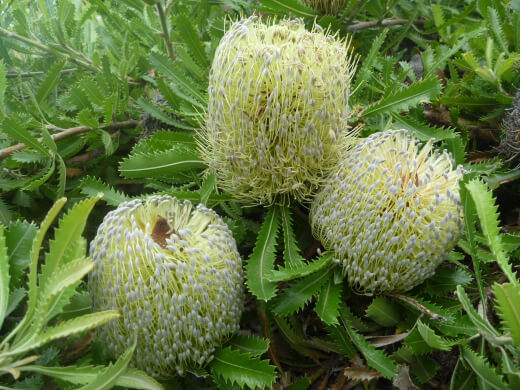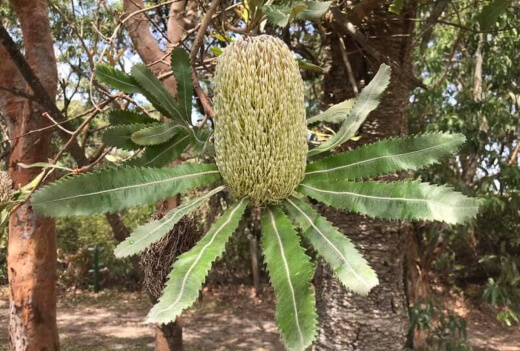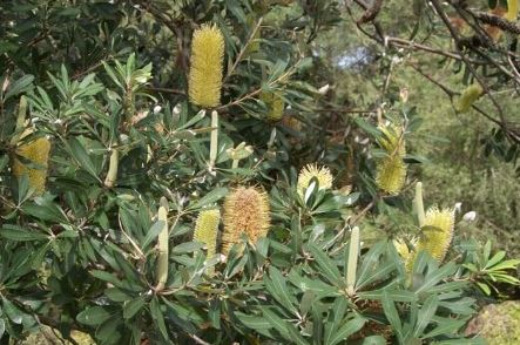We’ve already established that Banksia plants are a perfect option for those looking for a fuss-free, yet striking garden plant. However, the Banksia serrata is a relatively rare cultivar of the species.
Still, it’s a stunning soft-wooded, sub-tropical perennial which is relatively easily cultivated and an ideal option for beginner growers. Follow our growing and care guide to help you grow beautifully blooming Banksia serrata plants in your garden.
More...
What is Banksia serrata?

Source: Gardeningwithangus.com.au
Banksia form part of the Proteaceae family and grow natively across southern parts of Australia. The Banksia serrata species can be found growing all along the east coast of Australia, from Queensland to Tasmania.
This soft-wooded evergreen is considered a small to medium-sized tree, offering a medium growth rate. However, over its lifespan it can grow anywhere between 3 to 15 metres.
Banksia serrata cultivar, such as the Banksia ‘Pygmy Possum’ is an excellent option for those looking for a small growing tree. Banksia serrata is best known for its saw-like, serrated leaves and eye-catching green-yellow flowers.
Other common names include:
- Old Man Banksia
- Saw Banksia
- Banksia ‘Pygmy Possum’
Why Should You Consider Growing Banksia serrata?
The Banksia ‘Pygmy Possum’ has a lot of landscaping value, grown across many coastal landscapes and is even used for street-scaping. Not only is it exceptionally drought-tolerant, but it also requires very little maintenance once established.
It’s an ideal option for flower gardens, coastal gardens and can even function as a reasonably reliable screening plant or wind-breaker. Plus, the banksia serrata’s sought-after pollen supports local honey production and will attract lots of butterflies, bees and nectar-seeking birds.
How to Grow Banksia serrata

Source: Nationalparks.nsw.gov.au
Serrata plants are straightforward to cultivate, and luckily, seeds are readily available if you live near naturally growing serrata plants.
Propagation from seed is recommended, as it’s most comfortable and cost-effective. Even without any pre-treatment, your seeds will likely germinate anywhere between 3 to 4 weeks after sowing.
Propagation from a cutting is possible, but not recommended from this cultivar. Cuttings are very slow to strike and mostly end up being unsuccessful.
How to Propagate from Seed
Seed propagation is relatively straightforward, and you can source your seeds either from a licensed supplier or from an existing and healthy serrata plant. When collecting a seed pod, be sure to choose a large existing tree for maximum success.


Get Your Free Guide:
Master Growing Australian Natives eBook
A Must Have Complete Guide for Every Australian Garden
Get Your Free Guide:
Master Growing Australian Natives eBook
A Must Have Complete Guide for Every Australian Garden
Seeds can be collected throughout the year.
To propagate your serrata tree, you’ll need to:
- Place the seed cone into the oven at 120°C for about an hour.
- Once the seed pod opens, remove individual seeds with a sterilized pair of tweezers.
- Prepare your seeding mix by sterilizing it, as banksia are prone to fungal infection. A vermiculite seeding mix is recommended.
- Sow your seeds directly into the soil and keep the soil moist. Do not let the soil dry out fully.
- Transplant into a bigger pot or soil as soon as some small leaves appear.
Where to Grow Banksia serrata

Source: Davesgarden.com
Once you’ve propagated your seedling, it’s essential to choose the right spot for your serrata. While you can grow the serrata species in a pot, in the soil is preferred.
The most crucial factor is to give your serrata the right soil, sun and temperature conditions for ideal growth.
Soil
Ensuring the right soil is likely the most critical factor for Banksia growth. The serrata cultivar prefers sandy or loam soil with varying PH levels. The ground must be mostly-dry and well-draining. In general, try to avoid clay soils.
Sun
Banksias enjoy plenty of sunshine so choose a spot in your garden which receives lots of sun.
Temperature
The serrata cultivar is said to be frost-hardy. However, it grows best in sub-tropical warmer conditions.
How to Care for Banksia serrata

Source: Landscape.net.au
Once established, your Banksia serrata really won’t need much care beyond the occasional watering, fertilising and pruning.
In general, with most Banksia species, less is more, and they deal quite well with a little bit of neglect.
Watering Old Man Banksia
In the first two years of growth, it is recommended to water your Banksia regularly. You will want to keep the soil moist, but not water-logged as this will lead to disease.
After that, you can almost cut-back on watering completely, especially during seasons with heavy rainfall.
How to Fertilise Banksia ‘Pygmy Possum’
Again, regular fertilisation is only required within the first two years. In those years you can fertilise yearly, after that you can cut back to every few years. Over-fertilisation can cause your serrata to wilt, so be sparing with your fertiliser.
Pruning Your Saw Banksia
Pruning is mainly done to maintain size and shape. It’s crucial only to cut back new growth and avoid old growth. If you want to keep your serrata plant small, prune more frequently. Always ensure you use a sterilized blade or pruning saw to prune.
Your Banksia serrata will flower from September through to February. If you wish, you can cut back dead flowers. However, this will only be for aesthetic reasons and won’t affect your plant.
Common Banksia serrata Problems
At some point in your growth journey, you may ask yourself why your Banksia might be dying? While the Banksia serrata is relatively problem-free, there are three significant factors for which you’ll need to keep an eye out.
Why Are My Banksia Leaves Brown?
The browning of leaves is usually due to root rot, a common problem for Banksia plants. Root rot is the result of over-watering or waterlogged roots. If not treated, root rot can be a significant killer.
Be sure to re-plant your Banksia if possible and cut back on watering significantly.
Why Are My Banksia Leaves Yellow?
Yellow leaves are a sign of phosphorous toxicity. Banksia species are susceptible to phosphorous, and it can be dangerous for your plant, especially as phosphorous poisoning may only show signs 12 months later.
Ensure you make use of a low phosphorous fertiliser and avoid over-feeding at all costs.
Do Banksias Have Pest Problems?
You’re not likely to get many pest issues with most cultivars of the Banksia species. However, caterpillars seem to be drawn to Banksia plants. You can safely avoid caterpillars with natural repellents like neem oil or coffee grounds.

Final Tips for Growing Banksia serrata
You really won’t have any issues when it comes to growing Banksia serrata in your garden. However, here are some extra tips to make your growing journey a breeze.
- Sometimes wild seeds stay dormant for a long time. So, don’t be so quick to discard seeds that don’t seem to be germinating. Just give it some time.
- The serrata species have no problems with wind or salt spray, so long as you’re ensuring well-draining soil, you can grow it anywhere.
- Serrata flowers make fantastic centrepieces or part of floral arrangement, so, don’t be afraid to cut yourself some flowers. It won’t affect your plant’s health.
No matter where you decide to plant your Banksia serrata, you’ll be guaranteed years of beautiful blooms and lots of little garden visitors. Keep an eye on your watering and fertilisation and always remember that a little will go a long way when it comes to this cultivar.
So, go out and collect yourself some seed pods and start growing your very own Banksia serrata plants today.
Published on September 13, 2021 by Gary Clarke
Last Updated on February 21, 2024





Thank you for this. I am wondering whether it is possible to grow a Serrata in a wine barrel to try to limit the size it grows on our smallish block? Or do you suggest pruning is a better control technique. Thanks,
Mike
Hi Michael,
Banksia plants are suitable for container growth, so there really aren’t many reasons you couldn’t grow your banksia in a wine barrel – provided you’re choosing a large enough suited one. Plus, it’s a creative idea to add a little aesthetic value.
Just be to drill sufficient drainage holes into the base of the barrel, and pick a well-draining potting medium. You may also need to consider staking the base until the roots become established.
Pruning would be another option that can help you control size. Generally, banksias require little pruning but won’t be too badly affected with some rigorous pruning to control size.
Kind regards,
Gary Clarke